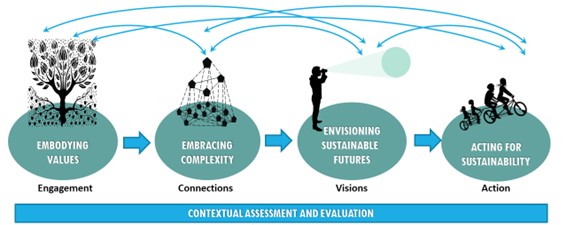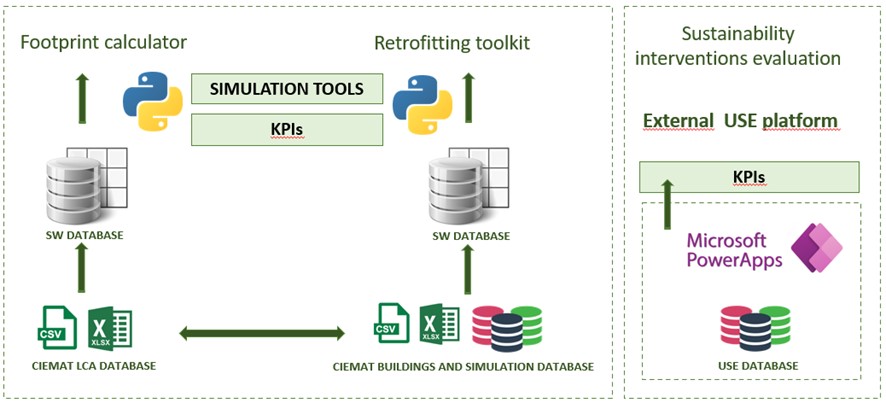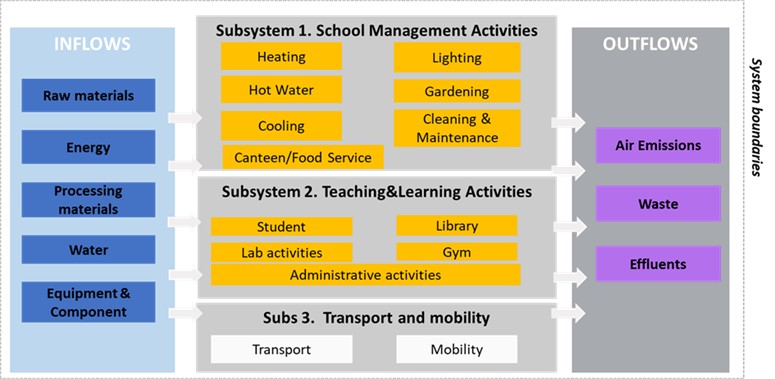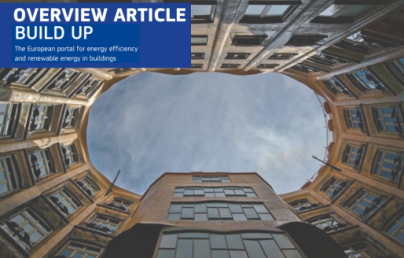Technical Article - The crucial role of Education in achieving sustainability and low carbon economy

Technical Article - The crucial role of Education in achieving sustainability and low carbon economy
Authors:
Emanuela Giancola (Energy Efficiency in Buildings Unit, CIEMAT)
Ana Prades (CISOT, CIEMAT)
Yolanda Lechón (Energy System Analysis Unit, CIEMAT)
Terhi Nokala (Finnish Institute for Educational Research, JYU)
Note: opinions in the articles are of the authors only and do not necessarily reflect the opinion of the EU.
The crucial role of education in achieving sustainable development was already stressed at the UN Conference on Environment and Development, held in Rio de Janeiro in 1992 and twenty years later at the UN Conference on Sustainable Development, ‘Rio+20’ in 2012. One of the seventeen UN Sustainable Development Goals (SDGs), adopted by the heads of state in 2015 as part of the 23 Agenda 2030, is specifically targeted at education. Moreover, education is a cornerstone and vital precondition for the achievement of the sixteen other goals.
Education is essential for increasing individual and collective knowledge, skills, values, and attitudes that would allow people to become responsible citizens and move towards sustainable development (OECD, 2018). It is indeed a catalyst of social and economic transformation towards sustainability. Target 4.7 of the SDG4 recognises this essential role and signals the need to enhance the sustainable development competencies of learners: “By 2030, ensure that all learners acquire the knowledge and skills needed to promote sustainable development, including, among others, through education for sustainable development and sustainable lifestyles, human rights, gender equality, promotion of a culture of peace and nonviolence, global citizenship and appreciation of cultural diversity and of culture’s contribution to sustainable development”.
The linkages between SDG4 and other SDGs are multiple (United Nations, 2019). There are five other SDGs that explicitly mention education: SDG3: Ensure healthy lives and promote well-being for all at all ages (Target 3.7), SDG5: Achieve gender equality and empower all women and girls (Target 5.6), SDG8: Promote sustained, inclusive and sustainable economic growth, full and productive employment and decent work for all (Target 8.6), SDG12: Ensure sustainable consumption and production patterns (Target 12.8) and SDG13: Take urgent action to combat climate change and its impacts (Target 13.3). However, the links are deeper and wider as the achievement of virtually all SDGs requires that the individuals, communities, and governments acquire the required competences through lifelong education. Education is not only an integral part of, but also a key enabler for sustainable development, it needs to be included in national development plans and strategies for achieving all the SDGs.
Policy and education communities have increasingly drawn upon a competence approach (Caena 2014) to increase transparency and communicability of learning, and to bring a broad understanding and a sense of urgency of sustainable development (Mochizuki & Fadeeva 2010). Competences can be broadly understood as “individual dispositions to self-organisation which include cognitive, affective, volitional (with deliberate intention) and motivational elements; they are an interplay of knowledge, capacities and skills, motives and affective dispositions” (Rieckmann 2012, p. 129). Sleurs (2008, p. 40) underlines the output-oriented nature of a competence-based approach, which asks “not what should be taught, but what should be learned, what abilities for acting, which concepts and problem-solving strategies people should have acquired as a result of the learning process”.
However, the theoretical foundations of competence-based approaches to education for sustainability remain weak, with the term ‘competences’ often defined vaguely if at all (Corres et al. 2020), with terms such as skills, literacy, competences, and capabilities often used interchangeably. Furthermore, competences for educators and those for students are sometimes treated without distinction, and competences specific to sustainable development are not always clearly distinguished from more generic competences associated with learning in general (Corres et al. 2020).
Plans for adopting sustainable development as one of the core institutional (UNESCO 2005 and individual (UNECE 2012; OECD 2018) competences have been called for globally. The UNESCO Expert Group on Competences in Education for Sustainable Development (UNESCO 2012) identified four priority points of action: professional development in education, governing and managing of institutions, curriculum development, and monitoring and assessment. The framework organises educators’ competences for ESD under four pillars of learning (i.e., Learning to Know, Learning to Do, Learning to Live Together and Learning to Be) and three principles (i.e., a Holistic approach, Envisioning change, and Transforming learning systems).
The ECF4CLIM Methodology
Through a multidisciplinary, transdisciplinary, and participatory process, the H2020 Green Deal ECF4CLIM (https://www.ecf4clim.net/) project develops, tests, and validates a European Competence Framework (ECF) for transformational change, which will empower the educational community to take action against climate change and towards sustainable development.
Applying a novel hybrid participatory approach, rooted in participatory action research and citizen science, ECF4CLIM co-designs the ECF in selected schools and universities by: 1) elaborating an initial ECF, supported by crowdsourcing , experts consultations, and analysis of existing ECFs, 2) establishing the baseline of individual and collective competences, as well as environmental performance indicators, 3) implementing practical, replicable and context adapted technical, behavioural, and organisational interventions that foster the acquisition of competences, 4) evaluating the ability of the interventions to strengthen sustainability competences and environmental performance, and 5) validating the ECF.
The proposed ECF is unique in that it encompasses the interacting STEM-related, digital, and social competences, and systematically explores individual, organisational, and institutional factors that enable or constrain the desired change. The novel hybrid participatory approach provides the broad educational community with an ECF adaptable to a range of settings, new ways of collaboration between public, private and third-sector bodies, and innovative organisational models of engagement and action for sustainability (Sustainability Competence Teams and Committees).
To encourage learning-by-doing, several novel tools are being co-designed with and made available to citizens, including a digital platform for crowdsourcing, IoT solutions for real-time monitoring of selected parameters, and a digital learning space. Participation of various SMEs in the consortium maximises the broad adoption and applicability of the ECF for the required transformational change towards sustainability.
The ECF4CLIM roadmap for education in sustainability (https://www.youtube.com/watch?v=tft6lyNrdkk)
The initial competence framework developed by ECF4CLIM aims to be a practical document that describes the essential individual and collective competences, as well as the key enablers and constraints, to enhance the environmental performance of educational institutions. It draws from the results of the ECF4CLIM crowdsourcing, document analysis, and literature review. It is based on and further develops the sustainability competences outlined in GreenComp - the European sustainability competence framework, developed by the Joint Research Center of the European Commission (JRC) (https://joint-research-centre.ec.europa.eu/greencomp-european-sustainability-competence-framework_en) (Bianchi & al. 2022). Our ECF is structured as a roadmap and aims to provide tools for different stakeholders to map and foster the enablers and overcome the constraints of sustainability in various educational contexts.
Our ECF4CLIM roadmap is comprised of the following four steps:
- Engaging people in promoting sustainability: It includes strengthening their understanding of sustainability and human dependence on the wellbeing of ecosystems. It strives to foster a collective will-formation process that considers different stakeholders’ needs, values, and perspectives.
- Deepening people’s understanding of the complexity of sustainability: It strives to help the educational community to ask the pertinent sustainability questions and allow them to create effective strategies for promoting sustainability. Successful promotion of sustainability requires an understanding of the given organisational context and mapping the relevant actors and learning content in different disciplines. Systemic understanding of the state of the environment and connections to global sustainability issues are also important. It is essential to acknowledge the impact that cultural backgrounds and different worldviews have on the problem framing and its possible solutions. It is important to ask what kind of knowledge we have, and how the knowledge base, interests, and principles vary among people and in different disciplines.
- Envisioning alternative futures: It maps possible paths towards sustainability and promoting adaptability for changes and action. Given the current challenges, such as climate change and biodiversity loss, what is the future likely to hold for us, and what kind of future do we want? Additionally, the focus should be on the changes and actions needed for realisation of preferable sustainable futures. Emotions have an impact on our cognitive and psychological adaptability. Therefore, a collective, supportive atmosphere with an active approach to sustainability is essential to promote a sense of hope, active coping, and an awareness how future depends on our actions. Transformation towards sustainability requires to change our perspective, question current assumptions and beliefs, foster transdisciplinary thinking, and unleash creative potential in order to create new solutions.
- Designing strategies for action: Relying on the previous values and principles, the systemic understanding of sustainability, and the envisioned sustainable futures: Who are the people and communities promoting sustainability, how? and where? Promoting sustainability requires multiple resources, such as people, time and space, money for procurement, pedagogical models and materials, collaboration and networking, as well as cultivating and utilising individual and collective human potential. The focus of action can be on gaining better resources, fostering relationships, as well as influencing attitudes and ways of talking and acting.
The road to promoting sustainability is not simple. Many aspects, interconnected issues, questions, and related details need to be considered in promoting concrete sustainability action in different contexts. The central purpose of the roadmap is to facilitate a participatory process that results in clarified visions and a purposeful strategy on how to proceed in promoting sustainability in each context and how to evaluate it.

Figure 1 - Overview of the ECF4CLIM Methodology
The ECF4CLIM participatory approach for testing the ECF
The project tests the competence framework in a participatory way with educational centres, used as demonstration sites, of different levels and European countries, and with public bodies, research centres and companies. The ECF4CLIM hybrid participatory approach, partially based on the STAVE tool and including elements of research and engagement (Horlick-Jones and Prades, 2014; Espluga et al, 2017), will allow the community to jointly identify, understand, assess and evaluate their own sustainability-related competences and obstacles for improvement. The communities engage in joint and reflective deliberation on how to promote sustainable individual and collective behaviours and evaluate the outcomes of the learning experience. This experiential learning will empower the broader educational community for a transformational change for a more sustainable future.
For the ECF testing activities, the project proposes an assessment-intervention-evaluation approach as depicted in figure 2. At each stage of this process, the addressed aspects include environmental indicators of school performance in key areas, individual competences (knowledge, skills, attitudes) and collective (organizational arrangements, social norms) competences. Thus, the baseline assessment examines - ex ante, prior to the intervention - the initial state of key environmental performance indicators, the level of knowledge, skills and attitudes at the individual level, and the organizational and institutional factors that enable or constrain the adoption of “sustainable” practices and behaviors at the individual and collective levels. This will be achieved by applying key performance indicators (KPIs), questionnaires, interviews, documentary analysis, and joint exploration in reconvened focus groups at the demonstration sites. The institutional enabling and constraining factors relate in particular to institutions that have a major role in the governance of the educational system (e.g., municipalities or regional authorities, legislation at various levels, education funding arrangements).

Figure 2 - The conceptual approach for developing and testing the European Competence Framework for climate change and sustainable development
ECF4CLIM Technical audits
In order to monitor the environmental performance at each demonstrative site (educational centers), a series of Key Performance Indicators (KPIs) are defined based on the data obtained from audits. These numerical indicators not only evaluate an educative center, but also compare its status and performance throughout the project.The environmental performance of the demonstration sites in Portugal, Spain, Romania, and Finland are assessed through technical audits. These audits are in progress, with the objective to characterise the environmental performance baseline of each school. The audits consist of three major parts: (A) pre-audit, (B) site assessment (audit), and (C) consumption and cost analysis. Environmental and energy performance are assessed through surveys and audits focused on resource consumption, the associated costs, and CO2 emissions. Seven environmental topics are considered: Transports, Green Procurement, Green Spaces, Indoor Air Quality, Energy, Water and Waste.
ECF4CLIM digital platform Simulators Space
To encourage learning-by-doing, the project is developing a digital platform where several novel tools are being co-designed with, and made available to, the educational centres.
One of these tools is the Simulators Space, that has three main components:
- Environmental footprint calculator
- Retrofitting Toolkit
- Sustainability Interventions Evaluation
The user’s entry point of information for the simulations is the Digital Platform, used to display all the results and allow the users to introduce different inputs in the tools. This platform is a web-based application.

Figure 3 - Overview of the Simulators Space
Environmental Footprint Calculator
The Environmental Footprint Calculator allows the calculation of the impact associated with the activity of the students, considering the typical complete system present in an educational centre. The calculator makes use of the multi-criteria and holistic approach offered by Life Cycle Assessment (LCA) following the guidelines of ISO 14040 and ISO 14044 standards.
LCA is a methodology that allows the evaluation of the environmental impacts associated to all the stages of a product's life cycle and encompasses extracting raw materials, processing, manufacturing, transportation and distribution, use, reuse and recycle and final disposal.
The framework of the development and LCA encompasses four phases: i) Definition of objective and scope, ii) Inventory Analysis, iii) Impact Assessment, and iv) Interpretation of results.
The goal of the calculator is the quantification of the environmental impacts associated to the consumption of energy, materials, and water of each demonstration sites located in the regions of Spain, Finland, Romania, and Portugal. The function considered in the LCA is the provision of education to a student for an annual season.
The scope of the system includes the operation and maintenance of the school building and learning and teaching activities, as well as daily mobility and transport (excursions, stays, etc.). The system thus identifies critical points and the potential for environmental improvement. In addition, a supplementary version of the calculator allows to include the home system, including consumption of energy, water, transport, etc., of the families of the students. This definition of the system is divided into three subsystems and has been previously used and validated in earlier investigations (Fig. 3).

Figure 4. Scope and system boundaries of the environmental footprint calculations.
A template to collect input data from schools has been designed to build the inventory (inputs and outputs of material and energy related to each component of the system). Considering the inventory data and main inputs and outputs, a database of the corresponding environmental impacts factors has been developed allowing the calculation of various impact. The International Reference Life Cycle Data System (ILCD) proposed by the JRC of the European Commission (European Commission, 2010) was used as characterisation method for these impacts. Finally, results are showed graphically which allows for an easier interpretation.

Figure 5. Groups of environmental impact categories included in the Environmental Footprint Calculator.
Retrofitting Toolkit
The design of a building under energy efficiency and sustainability criteria depends on different factors: climatology, urban layout, volume, construction variables, windows, dimensions and materials of shading elements, typology, and use of buildings. The final objective is to achieve high levels of comfort inside these buildings through greater or lesser exposure to solar radiation, the rational use of winds or the modulation of temperature and humidity. One of the elements used to facilitate the efficient and sustainable design of buildings is through surface maps of climatic and energy characteristics. These maps are graphical representations of environmental properties and heating and cooling requirements, allowing the quantification of indoor thermal comfort levels.
The giant steps that society and the world are taking in terms of digitisation are leading us to a new panorama in all sectors, including education. The digital transformation in schools is very present today.
The Retrofitting Toolkit aims to strengthen energy efficiency awareness among teachers, students, and the schools’ manager and personnel and to promote the engagement of the entire educational community in action towards behavioural changes towards energy efficiency and sustainability. This tool is also presented as an opportunity to make the educational community aware of the potential of digital technologies in traditional education and new ways to use it.
The Retrofitting Toolkit is developed in two new tools (Figure 5):
- Maps for building energy retrofitting proposals
- Dynamic building energy performance

Figure 6. Overview of the Retrofitting Toolkit
HOW IT WORKS. The toolkit selects the input data for each demonstration site and analyses the climatic characteristics of the area, identifies different measures to improve thermal comfort inside schools, estimates the heating and cooling needs based on the established set points, and quantifies the thermal needs of a classroom based on the proposed energy efficiency measures.
Results from these tools are very useful in the decision-making process to plan effective policies that consider the climate impact on the built environment of the selected schools and universities.
The operation of this Retrofitting toolkit has been developed through two tools (Tool1. Maps for building energy retrofitting proposals; Tool2 Dynamic building energy performance), which will allow users to analyse the improvement of energy efficiency in a sequential way, also climate trends, passive and active measures proposed for each demonstration site, estimation of the thermal requirements and quantification of the thermal needs.
Tool 1. Maps for building energy retrofitting proposals
This first tool is developed to provide climate and bioclimatic information of each demonstration site based on the weather files used. The tool is used in three sections:
- Climate maps, showing static results for each climate input.
- Bioclimatic strategies adapted to the climate zone of the school, showing static results for each climate input.
- Heating and cooling estimation, showing dynamic results for each climate.
The visualisation of the results of this tool will display different surface maps to highlight climate trends, indoor thermal comfort and the thermal estimation required to reach temperature set points. The use of these charts allows for quantifying the climate severity and predicting whether passive heating or cooling measures are likely to improve thermal comfort inside the schools.
This tool is available with the same level of access for all types of users, such as school managers, personnel, and staff, and school users, including students, teachers, etc.
Tool 2. Dynamic building energy performance
A dynamic energy building performance tool is being developed to evaluate the energy saving potentials achieved by the implementation of different retrofitting measures in schools. This tool gathers the initial building information, queries the simulation database available and quantifies the retrofitting percentage reached by the measures selected. This tool allows for estimating the energy response of a representative classroom when different retrofitting measures are implemented.
This tool is available with the same level of access for all types of users, such as school managers, personnel and staff, and school users including students, teachers, etc.
Sustainability Interventions Evaluation
ECF4CLIm proposes a participatory and deliberative evaluation focused on the capacity of the interventions to enhance the individual and collective sustainability-related competences, and to improve the performance of the selected educational organisations and institutions in the areas of climate change and sustainability. Pilot schools and universities will be involved in new environment assessments including IoT solutions, on-site measurement, data collection, questionnaires and visual inspection to evaluate the impact of the low carbon solutions on the energy and water use, amount of produced waste, transport patterns of the school community, use of green spaces, green procurement policy and indoor air quality. Evaluation is vital for the identification of obstacles, reasons for success and failure, and for the design of appropriate and context-sensitive solutions
Conclusion
The ECF4CLIM project will empower the educational community of Europe with a European Competence Framework (ECF) for transformational change, for the transition towards a climate neutral economy.
The diagnosis methodology allows obtaining information oriented to the energy and environmental analysis of each educational centre, easy to understand by technical and educational personnel, aimed both at improving the operation of the centre and at generating knowledge and learning. Identifying particular needs and common challenges is essential to guide action strategies towards decarbonization and achieve higher levels of sustainability in the education sector at all scales.
REFERENCES
- Caena, F. (2014). Teacher Competence Frameworks in Europe: policy‐as‐discourse and policy‐as-practice. European Journal of Education, 49(3), 311-331.
- Corres, A., Rieckmann, M., Espasa, A. & Ruiz-Mallén, I. (2020). Educator Competences in Sustainability Education: A Systematic Review of Frameworks. Sustainability 12(23): 10.3390/su12239858
- European Commission - Joint Research Centre - Institute for Environment and Sustainability: International Reference Life Cycle Data System (ILCD) Handbook – General guide for Life Cycle Assessment - Detailed guidance. First edition March 2010. EUR 24708 EN. Luxembourg. Publications Office of the European Union; 2010
- Mochizuki, Y., & Fadeeva, Z. (2010). Competences for sustainable development and sustainability: Significance and challenges for ESD. International Journal of Sustainability in Higher Education, 11(4), 391-403.
- Organisation for Economic Co-operation and Development (OECD). (2018). The future of education and skills: Education 2030. Paris: OECD. https://www.oecd.org/education/2030/E2030%20Position%20Paper%20(05.04.2018).pdf (accessed 30.03.2023)
- Rieckmann, M. Future-oriented higher education: Which key competencies should be fostered through university teaching and learning? Futures 2012, 44, 127–135.
- Sleurs, W. (2008). Competencies for ESD (Education for Sustainable Development) teachers: A framework to integrate ESD in the curriculum of teacher training institutes - Comenius 2.1 project 118277-CP-1-2004-BE-Comenius-C2.1. available at:https://unece.org/fileadmin/DAM/env/esd/inf.meeting.docs/EGonInd/8mtg/CSCT%20Handbook_Extract.pdf
- UNECE (2011) Learning for the future: Competences in Education for Sustainable Development; ECE/CEP/ AC.13/2011/6. Geneva: UNECE https://unece.org/fileadmin/DAM/env/esd/ESD_Publications/Competences_Publication.pdf (accessed 30.03.2023)
- UNESCO (2005), United Nations Decade of Education for Sustainable Development (2005-2014): International Implementation Scheme, October ED/DESD/2005/PI/01. Paris: UNESCO http://unesdoc.unesco.org/images/0014/001486/148654e.pdf (accessed 30.03.2023).
- United Nations, 2019. High Level Political Forum on Sustainable Development. Review of SDG implementation and interrelations among goals. Discussion on SDG 4 – Quality education (https://sustainabledevelopment.un.org/content/documents/23669BN_SDG4.pdf).


